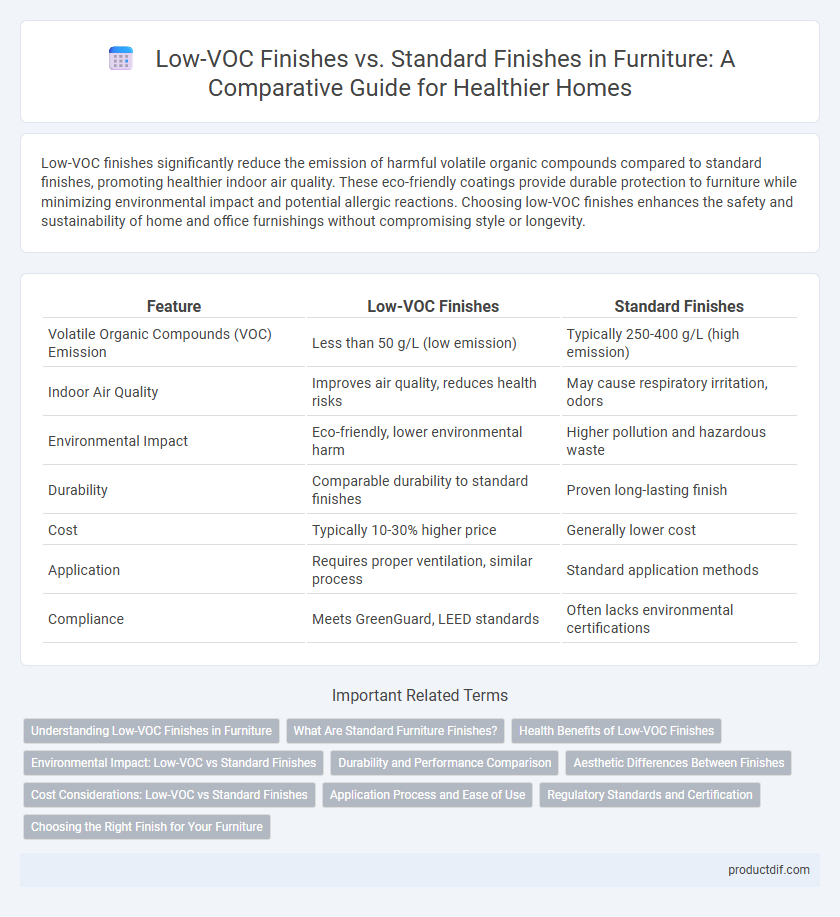Low-VOC finishes significantly reduce the emission of harmful volatile organic compounds compared to standard finishes, promoting healthier indoor air quality. These eco-friendly coatings provide durable protection to furniture while minimizing environmental impact and potential allergic reactions. Choosing low-VOC finishes enhances the safety and sustainability of home and office furnishings without compromising style or longevity.
Table of Comparison
| Feature | Low-VOC Finishes | Standard Finishes |
|---|---|---|
| Volatile Organic Compounds (VOC) Emission | Less than 50 g/L (low emission) | Typically 250-400 g/L (high emission) |
| Indoor Air Quality | Improves air quality, reduces health risks | May cause respiratory irritation, odors |
| Environmental Impact | Eco-friendly, lower environmental harm | Higher pollution and hazardous waste |
| Durability | Comparable durability to standard finishes | Proven long-lasting finish |
| Cost | Typically 10-30% higher price | Generally lower cost |
| Application | Requires proper ventilation, similar process | Standard application methods |
| Compliance | Meets GreenGuard, LEED standards | Often lacks environmental certifications |
Understanding Low-VOC Finishes in Furniture
Low-VOC finishes in furniture significantly reduce the emission of volatile organic compounds compared to standard finishes, promoting healthier indoor air quality. These finishes utilize water-based or natural ingredients rather than traditional solvents, minimizing harmful chemical exposure. Opting for low-VOC furniture coatings supports sustainable living and complies with stringent environmental regulations.
What Are Standard Furniture Finishes?
Standard furniture finishes typically include varnishes, lacquers, shellacs, and polyurethane coatings that create a durable surface enhancing wood grain while providing protection against moisture and wear. These finishes often contain high levels of volatile organic compounds (VOCs), which can contribute to indoor air pollution and pose health risks. Despite their popularity for aesthetic appeal and longevity, standard finishes are increasingly being compared to low-VOC alternatives that offer a safer and environmentally friendly option without compromising quality.
Health Benefits of Low-VOC Finishes
Low-VOC finishes significantly reduce the emission of harmful volatile organic compounds, improving indoor air quality and minimizing respiratory issues for furniture users. These eco-friendly coatings help decrease exposure to toxins such as formaldehyde and benzene, which are commonly found in standard finishes. Choosing low-VOC finished furniture supports a healthier living environment by promoting better air purity and reducing allergy and asthma symptoms.
Environmental Impact: Low-VOC vs Standard Finishes
Low-VOC finishes significantly reduce the release of harmful volatile organic compounds into indoor air, minimizing air pollution and health risks associated with toxic fumes. Standard finishes commonly emit higher levels of VOCs, contributing to smog formation and long-term environmental damage. Choosing low-VOC furniture finishes supports better indoor air quality and decreases overall environmental impact.
Durability and Performance Comparison
Low-VOC finishes offer enhanced durability by reducing chemical degradation and maintaining furniture integrity longer than standard finishes, which often contain harsh solvents that can weaken surfaces over time. These environmentally friendly coatings resist scratches, stains, and fading with sustained performance under regular use. Choosing low-VOC finishes improves indoor air quality without compromising the protective qualities essential for long-lasting furniture.
Aesthetic Differences Between Finishes
Low-VOC finishes often provide a smoother, more natural matte or satin appearance compared to the glossy, synthetic look typical of standard finishes. These eco-friendly coatings enhance the wood's grain and texture, resulting in a subtler and more sophisticated aesthetic. Standard finishes may emphasize shine and uniformity, which can sometimes obscure the material's inherent character in furniture pieces.
Cost Considerations: Low-VOC vs Standard Finishes
Low-VOC finishes typically involve higher initial costs compared to standard finishes due to the use of specialized, environmentally friendly chemicals and compliance with stringent health regulations. While standard finishes are often less expensive upfront, low-VOC options can reduce long-term expenses by improving indoor air quality and minimizing health risks for occupants. Choosing low-VOC finishes can be cost-effective over time when factoring in potential savings on medical costs and enhanced building value.
Application Process and Ease of Use
Low-VOC finishes generally require meticulous surface preparation and often need multiple thin coats for optimal coverage, ensuring safer indoor air quality during application. Standard finishes tend to have a thicker consistency, allowing quicker coverage but emitting higher levels of volatile organic compounds, which may require better ventilation. Both finishes offer ease of use, but low-VOC options might slightly prolong drying times, demanding patience and careful application techniques.
Regulatory Standards and Certification
Low-VOC finishes comply with stringent regulatory standards such as CARB (California Air Resources Board) Phase 2 and EPA (Environmental Protection Agency) guidelines, significantly reducing harmful emissions in indoor environments. Certifications like GREENGUARD and FloorScore validate low-VOC products for improved indoor air quality, ensuring they meet health and safety criteria. Standard finishes often lack these certifications, leading to higher volatile organic compound emissions that can negatively impact occupant health and regulatory compliance.
Choosing the Right Finish for Your Furniture
Low-VOC finishes significantly reduce volatile organic compounds emissions, promoting healthier indoor air quality while maintaining durability and aesthetic appeal in furniture. Standard finishes may offer a broader range of colors and finishes but often contain higher levels of harmful chemicals that can impact health and the environment. Selecting low-VOC finishes ensures sustainable, eco-friendly furniture with protection against toxins, making them ideal for homes with children or allergy-sensitive occupants.
Low-VOC finishes vs standard finishes Infographic

 productdif.com
productdif.com